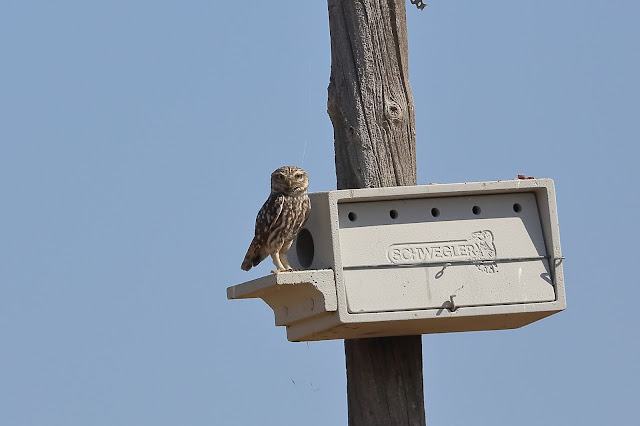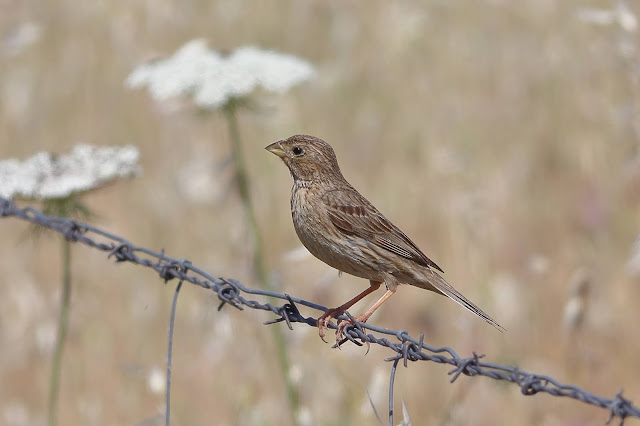Hola una vez más.
Hi again.
Hi again.
En el siguiente enlace podéis ver nuestros próximos viajes fotográficos y de observación de aves y mamíferos nacionales y al extranjero. Espero que os gusten y os animéis a venir conmigo. Una experiencia que nunca olvidareis. Estos viajes están condicionados a la situación en que se encuentren los destinos con respecto a la pandemia del coronavirus.
In the following link you can see our next national and foreign Birds and Mammals photographic and observation trips. I hope you like them and I encourage you to come with me. An experience that you will not forget. These trips are conditioned to the situation in which the destinations are with respect to the coronavirus pandemic.
Esta vez os enseño algunas de las aves que pude fotografiar en nuestro viaje programada a los Llanos de Cáceres y el Parque Nacional de Monfragüe que hice el 29 del pasado mes de mayo.
This time I show you some Birds that I was able to photograph on our scheduled trip to the Llanos de Cáceres and the Monfragüe National Park that I did on May 29.
El día fue más caluroso de lo acostumbrado pues llegamos hasta los 35 grados centígrados. Sin embrago el día fue soleado.
The day was hotter than usual as we reached 35 degrees Celsius. However, the day was sunny.
En una parada para tomar un café ya tuvimos la posibilidad de ver a unas grajillas occidentales (Corvus
monedula).
In a stop to take a coffee we already had the chance to spot Eurasian
Jackdaw.
Y a este inmaduro de águila imperial ibérica (Aquila
adalberti). Bonito ejemplar.
And this immature Spanish
Imperial Eagle. Nice specimen.
En los Llanos de Cáceres, en los nidos que están puestos para las carracas europeas (Coracias
garrulus) albergan también otros inquilinos. En la foto un mochuelo europeo (Athene
noctua).
At Llanos de Cáceres, in the nests that are placed for the European Rollers, they also house other tenants. In the photo a Little Owl.
Las bellas carracas europeas (Coracias garrulus).
The beautiful European Rollers.
También los estorninos negros (Sturnus
unicolor) utilizan los nidos de las carracas.
Also Spotless
Starling use the nests of the Rollers.
Una culebrera europea (Circaetus
gallicus) andaba en busca de serpientes por la zona.
A Short-toed
Eagle was looking for snakes in the area.
Conforme iba pasando la mañana el calor iba aumentando.
As morning was passing, heat increased.
Después de observar bastante rato las carracas, nos adentramos por los carriles de los llanos. En la foto una cogujada común (Galerida
cristata).
After observing the carracks for some time, we make a tour bu the trails of the plains. In the photo a Crested
Lark.
Otra.
Another.
Aguilucho lagunero occidental (Circus
aeruginosus).
Eurasian Marsh
Harrier.
Había muchos escribanos trigueros (Miliaria
calandra). En la foto un adulto.
There were many Corn Bunting. In the photo an adult.
Un juvenil.
A juvenile.
Muy pocas veces veo a un individuo melánico de aguilucho cenizo (Circus
pygargus).
Very rarely do I see a melanic Montagu's Harrier.
Y cuando nos íbamos en dirección al Parque Nacional de Monfragüe pude sacar a las carracas europeas (Coracias garrulus) posadas en los postes en lugar de los cables que las fotos me gustan menos.
And when we were going in the direction of the Monfragüe National Park, I was able to photograph European Rollers perched on poles instead of on telephone cables that photos are less beautiful.
Macho de cernícalo primilla (Falco naumanni).
Male Lesser
Kestrel.
Female.
Llegamos al Parque nacional de Monfragüe a la hora de almorzar. Un macho de roquero solitario (Monticola
solitarius) que sufre de leucismo parcial estaba por uno de los observatorios.
We arrive at the Monfragüe National Park at lunchtime. A male Blue Rock
Thrush with partial leucism was very close of one of the observatories.
El leucismo no se aprecia bien en esta foto pues lo tiene por el otro lado de la cabeza y en el dorso.
The leucism is not well appreciated in this photo because it is on the other side of the head and on his back.
Una hembra.
A female.
Un vídeo del susodicho macho.
A video of the aforementioned male.
Se podían ver tres nidos de cigüeñas negras (Ciconia nigra).
We were able to spot three black stork nests.
Uno de ellos con tres pollos.
One of them with three chikcs.
Al estar dos de los nidos muy cercanos había continuas trifulcas entre los progenitores de ambos nidos.
As two of the nests were very close, there were continuous fights between the parents of both nests.
Las amenazas entre ellos.
Threats between them.
Otro de los nidos también con tres pollos. Me encanta ver como los padres dan sombra a sus pollos con las alas.
Another of the nests also with three chicks. I love watching parents shade their chickens with their wings.
Una golondrina dáurica (Hirundo
daurica).
Red-rumped
Swallow.
Como de costumbre había muchos buitres leonados (Gyps
fulvus).
As usual there were many Griffon Vultures.
Vimos varios ejemplares de picogordo (Coccothraustes
coccothraustes).
We saw several specimens of Hawfinch.
Un joven de herrerillo común (Cyanistes
caeruleus).
A juvenile Blue Tit.
Hembra de ciervo común (Cervus elaphus).
A Red Deer hind.
Otra.
Another.
Buitre negro (Aegypius
monachus).
Black
Vulture.
Pudimos contemplar dos nidos de alimoche común (Neophron
percnopterus).
We were able to see two nests of Egyptian Vulture.
Escribano montesino (Emberiza
cia).
Rock Bunting.
También vimos un escribano soteño (Emberiza
cirlus).
We also saw a Cirl
Bunting.
En portilla del Tiétar no había nada más que un buitre leonado (Gyps
fulvus) adulto y un solo pollo. Me imagino que la tormenta Filomena ha debido de causar muchas muertes de los pollos. Nunca había visto este sitio con tan pocos buitres. En el video el único pollo que vimos arreglándose las plumas.
In thePortilla del Tiétar there was nothing more than an adult Griffon Vulture and a single chick. I imagine that the storm Filomena must have caused many deaths of the chicks. I have never seen this place with so few Vultures. In the video the only chicken we saw fixing its feathers.
Si queréis suscribiros a este blog de los viajes que hacemos pincha en el siguiente enlace: Suscribirse y haz clic en ¿ Quieres suscribirte a nuestro blog?
If you want to subscribe to this post about the trips we do, click on the following link: Susbcribe and click on: Do you want to subscribe to our blog?
Espero que os haya gustado y hasta pronto.
I hope you like it and see you soon.







































No hay comentarios:
Publicar un comentario